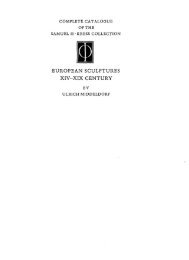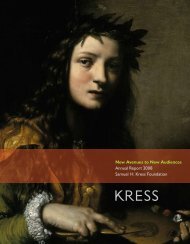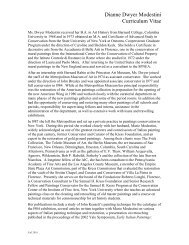The Campus Art Museum - Samuel H. Kress Foundation
The Campus Art Museum - Samuel H. Kress Foundation
The Campus Art Museum - Samuel H. Kress Foundation
You also want an ePaper? Increase the reach of your titles
YUMPU automatically turns print PDFs into web optimized ePapers that Google loves.
<strong>The</strong> Exemplary <strong>Campus</strong> <strong>Art</strong> <strong>Museum</strong> Director<br />
Interviewees suggested the seven actions of successful leaders of exemplary campus<br />
art museums that are discussed below. All of these actions are supported by the<br />
exemplary director’s commitment to his or her campus art museum. That is, they<br />
do not view the job as a “stepping stone” to some other position and they devote<br />
their time and energy to the museum. As described by a curator, “[<strong>The</strong> director] has<br />
charisma, energy, vision. And she’s genuine, totally committed. She’s giving two<br />
hundred percent. It doesn’t feel hard for the rest of us just to give one hundred and<br />
twenty percent.”<br />
Development of a Thoughtful Mission or Plan for the <strong>Museum</strong>. <strong>The</strong><br />
mission statement generally became a focal point of discussions when current<br />
directors arrived. Several initiated procedures for clarifying and creating new<br />
mission statements as described by one director, “<strong>The</strong> mission statement when I<br />
got here was forty-six lines long and defined which kinds of students we served.<br />
When I got here, I asked everybody what the mission was and nobody could tell<br />
me, because they had no clue.” At other institutions, the mission statement was part<br />
of discussions in helping to set a direction or vision for the museum as described by<br />
another director:<br />
This person wanted us to change the mission, but what she was really talking<br />
about was the vision statement. I said, “We can’t change our basic mission.…<br />
What we can change is how we envision doing that, who we think our<br />
audiences are.” So we… really came to the conclusion that our first audience is<br />
our students and our faculty and we decided to gear the communication level<br />
to an educated non-specialist….<br />
In general, the exemplary campus art museum director and staff examined<br />
the mission; came to an agreement on not only goals, but also procedures; created<br />
a plan; and then examined each action of the museum in light of that agreed-upon<br />
direction. As more than one director noted, “It’s really very, very important to be<br />
strategic because we can’t afford to have one penny that doesn’t go towards our goal.<br />
Every single thing we do, we think about, we question, we say, ‘Is this something<br />
that really advances our mission or our strategic plan?’” See Appendix IV.B. for the<br />
mission statements of museums participating in this study.<br />
Creation of a Collaborative Working Environment. <strong>The</strong> successful director<br />
facilitates collaboration among staff so that they feel part of a team. “We have a<br />
very cohesive staff,” commented a staff member. “Everybody feels as though we are<br />
working towards making the [campus art museum] as welcoming and as interesting<br />
as it can be.” Weekly meetings are part of this process, with museum directors<br />
reporting, “We have weekly staff meetings and I try to call special groups together<br />
to talk about things.”<br />
Occasionally, creating this cohesive team requires the difficult task of<br />
replacing some staff with new people with similar philosophies. Some directors<br />
“encouraged” people to leave through increasing expectations. Others were more<br />
direct:<br />
It’s Not History and Culture Alone: People Make the <strong>Museum</strong><br />
14
















